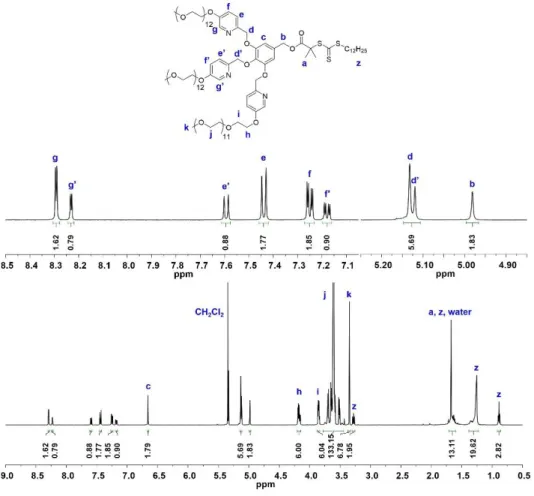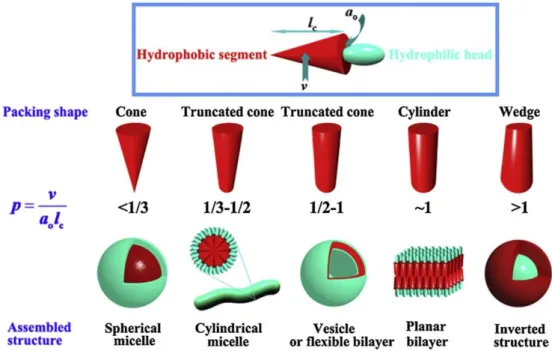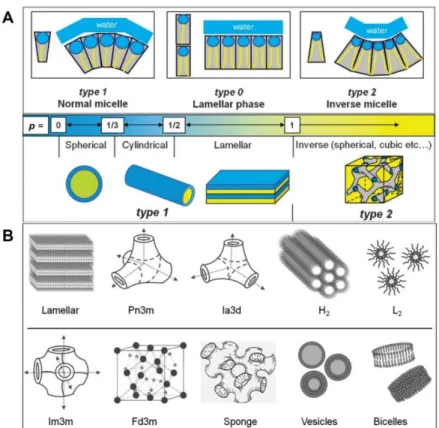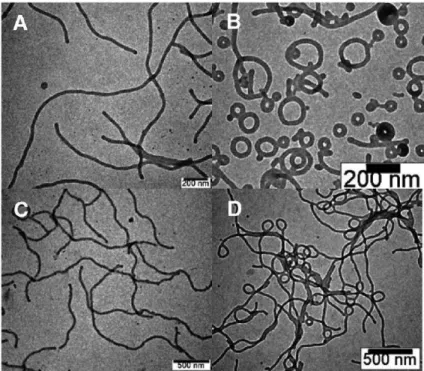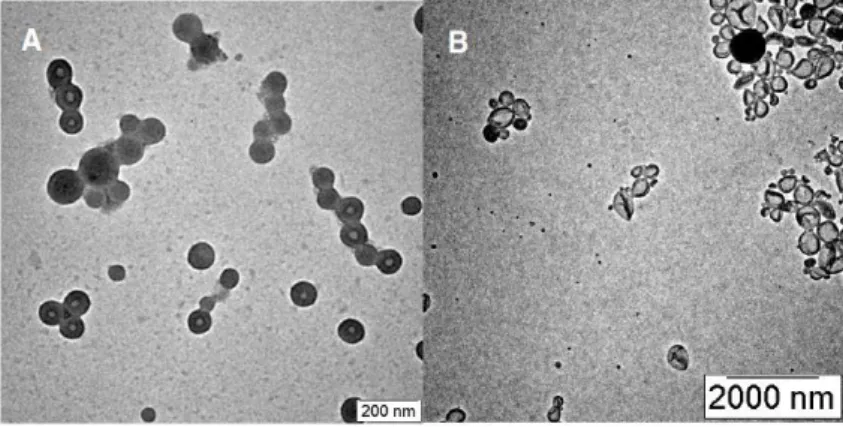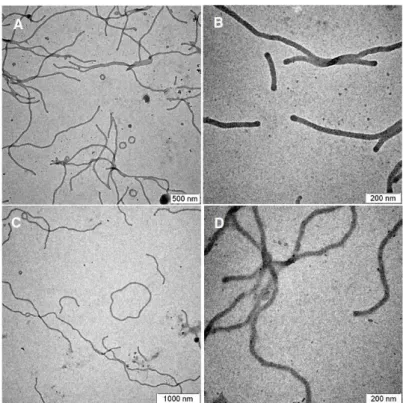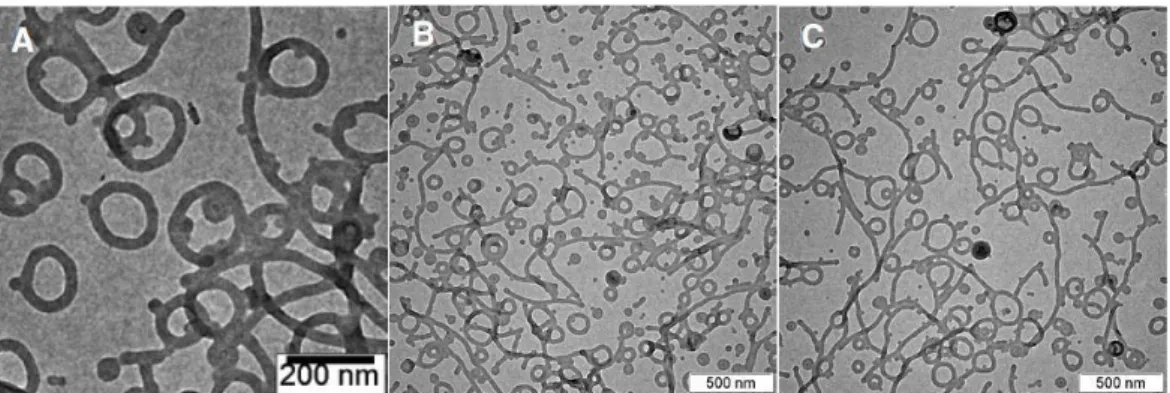The molecular weight of the PEG segment is fixed at approx. A) MALDI-TOF spectra of linear PEG (L1) and PEG-based macroinitiators (D1, D2). Representative TEM images of 9(PEG7)-PS150 micelle solutions immersed at 25% water content.
Introduction
- Self-assembly
- Preparation of block copolymers
- Self-assembly of block copolymers in bulk
- Self-assembly of block copolymers in solution
- Various morphologies from solution self-assembly of block copolymers
- General method to control morphologies
- Controlling morphology by molecular design
- Controlling morphology by external stimuli
- Thermo-responsive morphological transition
- pH-responsive morphological transition
- Stabilization of morphology by cross-linking
- Photo-cross-linking of block copolymers
- Summary of thesis
- References
Self-assembly of dendritic-linear block copolymers with fixed molecular weight and block ratio. Solution Self-assembly of block copolymers containing a branched hydrophilic block into inverse bicontinuous cubic mesophases.
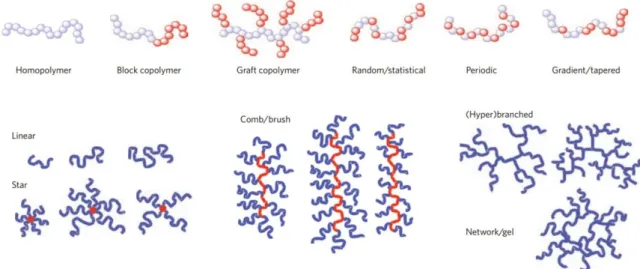
Self-Assembly of Dendritic-Linear Block Copolymers with Fixed Molecular Weight
Abstract
Introduction
In this chapter, we describe a new design concept to synthesize amphiphilic block copolymers to rationally control the topology of the self-assembled structure. Our design includes a hydrophilic block built on a dendritic scaffold27-30 for which the number of peripheral hydrophilic chains can be precisely controlled while the overall molecular weight of the hydrophilic segment is unchanged by matching the molecular weight of the individual peripheral chains (Figure 2-1 ). This enables us to induce a change in molecular packing geometry at the interface of the hydrophobic core of the micelle without significantly changing the weight ratio between the two blocks.
As a result, we induce a topological change in cylindrical micelles from linear cylinders to toroidal or lasso (a ring attached to a linear cylinder) micelles resulting from differences in the steric effect on the micelle corona. Our results contribute to a better understanding of the structure-behavior relationship in the self-assembly of block copolymers in solution and may provide a new way to rationally control the morphology of self-assembled micellar and vesicular structures.
Results and Discussion
We therefore reduced the concentration of the block copolymer in dioxane solution to 0.05 wt% to prepare micelles. The yield of toroidal micelles was determined by counting the number of micelles from the TEM images taken from a single grid (a total of 200 micelles were counted). These results suggested that 3(PEG22)-PS152 possesses the packing factor that allows cyclization of micelles due to the branched architecture of the hydrophilic block.
Representative TEM images of the micellar solutions of 3(PEG22)-PS152 quenched at the water content of 25%. To unravel the possible pathway of the formation of a lasso micelle, we studied the kinetic effect on the micellization of the block copolymers. To prove our hypothesis of the increased steric effect of the dendritic architecture on self-assembly, we measured Π–A isotherms of linear and dendritic block copolymers.
It has been reported that the molecular area of PEG-b-PS block copolymers exhibited an increase with increasing molecular weight of the PEG block, which.
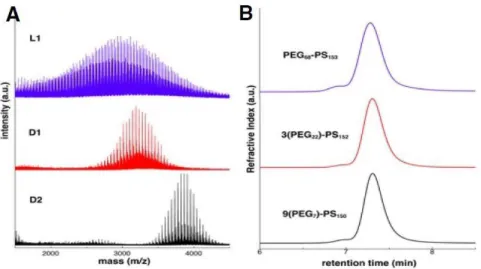
Summary
Experimental
In a typical experiment, 20 μl of the polymer solution (1 mg/ml) was spread evenly over the water surface in small droplets. The filtered solution was evaporated on a rotary evaporator and the resulting residue was redissolved in CH 2 Cl 2 (10 ml), which was precipitated in cold diethyl ether. When the molecular weight of the block copolymer reached the desired value, the reaction was quenched by exposing the solution to air in an ice/water bath and diluted with CHCl 3 (15 mL).
The cooled solution is filtered through a pack of alumina (basic) with CHCl3 to remove the Cu catalyst. The filtered solution was concentrated on a rotary evaporator and the resulting residue was diluted with 20 mL of CH2Cl2. The remaining solution was dialyzed (SpectraPor, molecular weight cut-off Da) against water for 24 h with frequent water changes.
In all cases, the morphology of the micelles after rapid quenching and dialysis for 24 h was the same based on TEM observation.
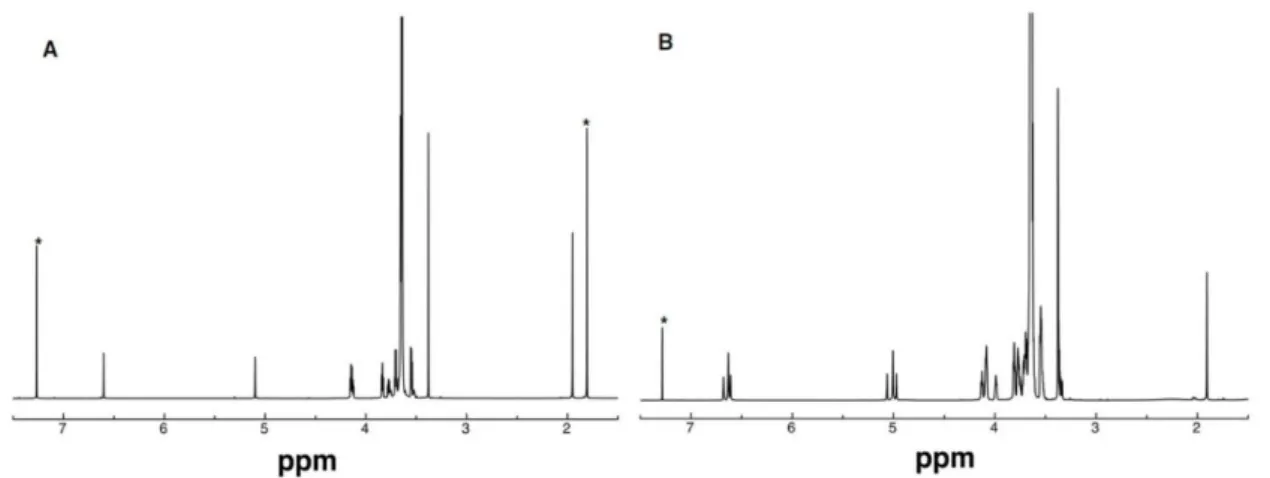
After the addition of 2 mL of water, 50 μL of the suspension was taken and added at once to 2 mL of pure water while stirring.
Abstract
Introduction
Covalent Stabilization of Bicontinuous Inverse Cubic Structures of Block Copolymer Bilayers by Photodimerization of Polystyrene Indene Pendant Groups. Cross-linked PS prepared by chemical cross-linking using divalent cross-linkers, such as divinylbenzene, is an indispensable material to be used as a stationary phase for synthesis and solid-phase separation.29 Irradiation of PS chains using long-wavelength UV light short (λ = 254 nm) generates radicals: PS can cross-link in bulk by the recombination of these radicals.30 Uncontrolled association of PS domains of self-assembled BCP structures, such as microphase-separated nanostructures and polymer micelles deposited on the substrate, can provide robust self-assembled structures upon exposure to solvents.31 However, cross-linking of PS chains in solution has not been performed in a controlled manner using photochemistry (e.g., cycloaddition ). Controlled radical polymerization of styrenic monomers with photocurable pendant groups can benefit from the synthesis of well-defined PKKs from self-assembled nanostructures of various shapes that can be covalently stabilized under harsh conditions.
The self-assembled structures were cross-linked by [2π + 2π] cycloaddition of indene groups upon irradiation of long-wavelength UV light (λ = 365 nm). We report core-crosslinking of complex, self-assembled structures of BCPs through the [2π + 2π]-cycloaddition of indene moieties32,33 present in a hydrophobic block based on PS. We demonstrate that the micellar structures and complex inverted bicontinuous bilayers of BCPs containing the hydrophobic PS polymer block with indene pendant groups can be covalently stabilized in aqueous solutions after irradiation with long-wavelength UV light (λ = 365 nm).
This process cross-links hydrophobic compartments of self-assembled nanostructures without any additional reagents or morphological change during cross-linking (Figure 3-1).
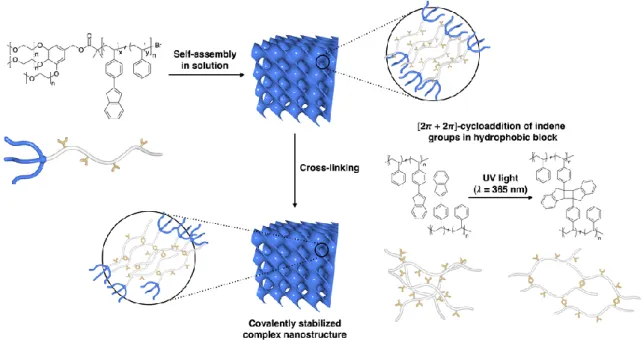
Results and Discussion
The photodimerization of the indene pendant groups of the polymer chains under UV irradiation was studied in solution. UV-Vis absorption spectra of the cross-linked film of P1 showed a decrease in the peak ( = 310 nm), indicating the formation of cyclobutane bonds of the indene dimer (Figure 3-7). These results confirmed that the [2 + 2]-cycloaddition of the indene pendant groups of P1 and P2 induced cross-linking of the polymer chains in solution.
The dangling groups of the PS block were converted to indene groups in the presence of the Burgess reagent at room temperature. 1H NMR and GPC analyzes clearly showed the complete conversion of the pendant groups to indenes. Self-assembled structures of the BCPs in water were easily cross-linked by irradiating the aqueous dispersion with UV light (λ >300 nm, 200 W) for 5 h.
The polymer cubosomes of P6 in water were irradiated with UV light for 1 h at room temperature to induce photodimerization of the indene pendant groups within the hydrophobic compartment of the bilayer.
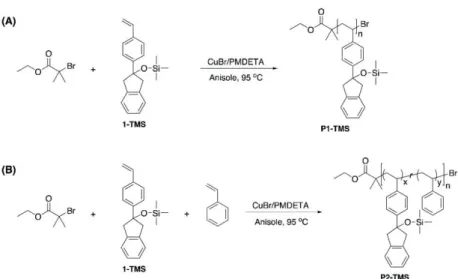
Summary
Experimental
The samples were prepared by placing a drop of the solution on a carbon-coated Cu grid (200 mesh, EM science). Then the reaction mixture was stirred for 1 hour at -70 °C and the temperature was slowly raised to room temperature by removing the dry ice/acetone bath. The reaction mixture was quenched by adding water and extracted with CH2Cl2 (50 mL × 3 times).
When the molecular weight of BCP reached the desired value, the reaction was quenched by exposing the solution to air in an ice/water bath and diluted with CHCl3 (5 mL). Then, the solution was precipitated in methanol (40 mL) and the product was concentrated by centrifugation (4,500 rpm, 10 min). A white solid (P5-OH) was collected and dried under reduced pressure. triethylammonium sulfonyl)carbamate (Burgess reagent, 786 mg, 3 equiv. of 1-OH groups) was dissolved in anhydrous benzene (8 mL) and the solution was degassed by bubbling N 2 for 15 min.
For tracking, 0.05 ml of the sample was collected and diluted with water or THF 40 times to its original volume to prepare the sample for DLS.
The vial cap was replaced by a rubber septum and water was added to the polymer solution for 4 h using a syringe pump with a 6 ml syringe equipped with a steel needle. The resulting suspension was dialyzed (molecular weight cutoff 12 to 14 kDA (SpectraPor, Rancho Dominguez, CA)) against water for 24 hours. Photo-crosslinked diblock copolymer micelles: Quantitative study of photochemical efficiency, micelle morphologies and their thermal behavior.
Multiple morphologies, phase transitions, and cross-linking of crew-cut aggregates of polybutadiene-block-poly(2-vinylpyridine) diblock copolymers. The preparation and characterization of extended network and macroporous styrene-divinylbenzene copolymers and their sulfonates. Photochemical fixation of structures in binary polymer brushes - Influence of layer thickness and grafting method.
Structural requirements of block copolymers for self-assembly into inverse bicontinuous cubic mesophases in solution.
Polymer Cubosomes with Lattice Parameters Comparable to Biological Lipid Cubic
- Abstract
- Introduction
- Results and Discussion
- Summary
- Experimental
- References
C in the presence of the macroinitiator 1 without CuBr/PMDETA; this resulted in no detectable polymerization. The Mn of the BCP was adjusted by controlling the duration of the polymerization reaction. The SEM images of the polymer cubosomes of BCP 3 (Figure 4-12A, B) showed the presence of surface pores, and suggested that the internal mesophases have double diamond lattices (Pn3m symmetry).
TEM images of the polymer cubosomes of 3 (Figure 4-12C, D) suggested the presence of internal P surface (Im3m symmetry) by revealing the (100) projection of the lattices. From the TEM images, the lattice parameter of the internal P surface was estimated to be ~200 nm (Figure 4-13). Our results confirm that the increased molecular weight of the BCP correlates with the increased lattice dimension of the self-assembled TPMS formed by solution self-assembly.
The reflectance spectrum of the polymer cubosomes (PCs) was measured on a CRAIC 20/20 PV microspectrophotometer in 200-800 nm spectral region μm2 aperture size).
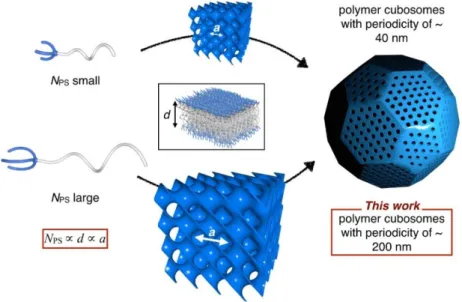
Morphological Transitions of Multi-Stimuli Responsive Branched-Linear Block
- Abstract
- Introduction
- Results and Discussion
- Summary
- Experimental
- References
Target BCPs were dissolved in a good solvent (0.5 wt%) and the bad solvent was introduced into the polymer solution via a syringe pump at constant speed (0.5 mL h-1). bMorphologies of self-assembled structures; The morphologies of self-assembled structures could be estimated from the block ratio, which was directly correlated with fraction of PEG, fPEG. From P1 to P4, the morphologies of self-assembled structures became more complex, from micelles to lamellae structures.
TEM images of self-assembled structures of block copolymers lacking pyridine groups in a neutral state B1-1 (A) and B2-1 (C) and an acidic state B1-2 (B) and B2-2 (D ). From the series of experiments, we confirmed that the self-assembled structures of our BCPs with pyridine groups in connection points of three PEG chains could be transformed by controlling the pH of the solution during self-assembly. For the control experiment, the same BCP with benzene groups instead of pyridine groups, B2, was self-assembled in the same way.
The resulting suspension was poured into 10 ml of acetonitrile to quench the morphology of self-assembled structures.
